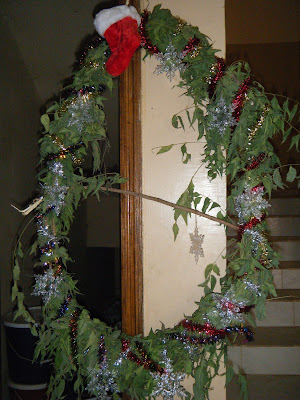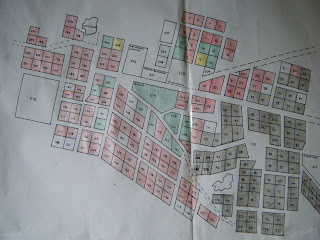 |
| "Zazu Bird" |
As promised, here are a few bits and pieces from my last month or so at site. Its been a bit of a slow month as I wait to see if my latrine grant will be approved for funding. In no particular order, here is how I've filled my time:
 |
| Showing off the germs |
Global Hand Washing Day
October 15th was Global Hand Washing Day, and my neighbor Aimee and I celebrated it in her village with a hand washing demonstration with the kids. Aimee led most of the session and I was just there for moral support and crowd control. We started out with an explanation about germs, given by the local health worker, and then moved on to some hand's on demonstrations. Using glitter to represent "microbes," we showed the kids how just dipping your hand into a bowl of water, the way most families "wash up" before meals, doesn't remove all of the germs. Then we had the kinds wash their hands with soap and lo and behold all the germs were gone! Then we demonstrated how germs get transmitted from person to person by coating one child's hand and having them shake hands with the kids around them. We wrapped up the day with a hand washing relay race and a banner pledging "I will wash my hands with soap" that all the children signed by applying their hand-print in paint (and since it was automobile paint, the only kind available here, the kids subsequently spent the next 45 minutes trying to wash it off their hands, thus reinforcing the message).
 |
Kids in their back to school T-shirts and hats,
thanks to "Uncle Mike" |
Back To SchoolAt some point this month the kids are scheduled to start going back to school. The school "opened" on October 6th, meaning all of the teachers showed up and had the students weed the school yard and sweep out the classrooms, at which point they promptly disappeared for two weeks. There has been some activity at the school these last two days, so perhaps the real learning will start soon. As soon as the school is back on a regular schedule we will start back up with the school garden. The womens' group has been taking care of it over the rainy season, but besides a healthy crop of eggplant there isn't much going on in the garden right now.
Sidewalk Chalk Goes Vertical
My brother who lives in Dakar recently started construction on the first ever cement structure in our compound. Its a one-room building with a small 4x4 foot porch and a little closet, for his wife and new baby. As exciting as it is to build something that will last more than two rainy seasons, its not exactly the most beautiful addition to the middle of our compound. A bag of sidewalk chalk and a handful of my little brothers quickly remedied that situation.
Found: Cutest Puppy Ever
On the way to the road town I found a lone puppy, in the middle of the path in the middle of nowhere. I searched the road town for his mother but couldn't find her, and he was too small to be left on his own, so I took him home. I named him Mo' which means "lost" in Seereer. I knew I couldn't adopt a dog here, because I would fall in love and have to take it back to America, so I spent a week trying to find it a new home. Eventually the woman that runs the French Epicerie in Kaolack adopted him, so now I can rest easy knowing he'll be well taken care of.
Latrine Project
Before writing my latrine grant I went from household to household in my village to observe the bathroom situation and make this map. The compounds shaded in grey are part of the Wolof neighborhood, where I can't work because the Imam who controls it refuses to work with white people, or women, or both, I'm not really sure. The compounds shaded in green have a functioning latrine, and the compounds shaded in red have no latrine facilities at all and have to go out to the fields to do number 2. As you can see, the red far outweighs the green, so we're in serious need of some latrine building. Hopefully my grant application will be approved, and we will be able to build at least 15 more latrines spread around the village.
 |
I've got the bullet hole, now I just need to come up with a
good story |
Badge of Honor
Something funny happens when you enter the Peace Corps... things that should be deeply personal and embarrassing suddenly become a source of pride. Poop your pants? Call your neighbor! Diarrhea and vomit at the same time? Announce it to every volunteer you meet! We are constantly exchanging stories, comparing and contrasting diseases, and discoursing on bowel movement consistency. Its probably some sort of coping mechanism...a way of reassuring yourself that you aren't the only one suffering these horrors, and bonding with your fellow volunteers. So when I developed a skin infection on my leg at the beginning of the rainy season, a fate that every single volunteer suffers at some point during their service as a result of wading through feces infested waters, I wasn't ashamed. Actually, I was a bit proud. When it persisted a month, and then two months, I started to get a little worried, but other volunteers found it absolutely fascinating. The first thing out of their mouths when they found out the reason for the bandages was "Oooh let me see!" Then followed a hearty discussion about similar conditions, possible diagnoses, and alternative treatments. Three months, two tubes of neosporin, a bottle of hospital disinfectant and a full round of antibiotics later, the little infection that could was still going strong, so I made a trip to the med office in Dakar to have it checked out. Turns out I had a strep infection, yea like the kind in your throat, in my skin. Nothing an extremely painful pressure-washing, another 14 day course of penicillin and a bunch of fluffly clean bandages can't cure...right? We're now on month four, and although the infection is gone and its beginning to heal, the crater in my leg has far from disappeared. Its going to leave a terrible scar, one that I'll wear as a badge of honor, at least as long as I'm in Senegal. But you can bet I'll be making a trip to the dermatologist not long after I get home.


















































